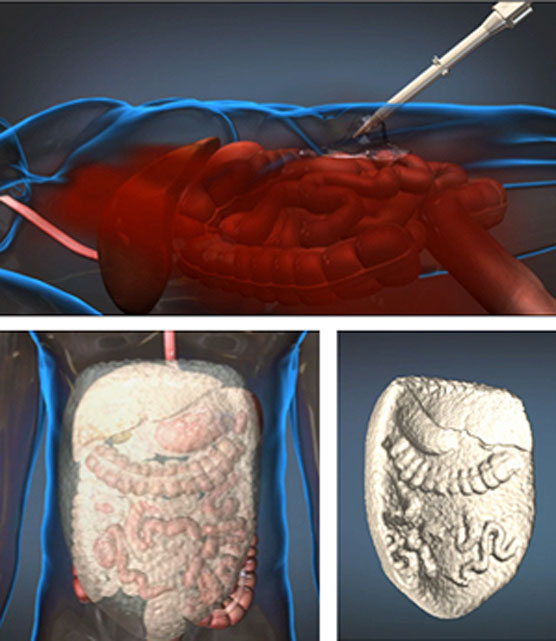آژانس پروژه های تحقیقاتی پیشرفته دفاعی (DARPA) در حال توسعه نوعی از فوم است که می تواند به زخم های بدن در اثر میدان جنگ وارد شده و از آنها در برابر خونریی داخلی حفاظت کند
این نوع فوم تزریقی بوده و از طریق نوعی سرنگ شبیه به خودکار به زخم ها وارد می شود . این سازمان امیدوار است زمانی که این فوم کامل شد بتواند به سربازان و مصدومان حوادث برای زنده ماندن تا زمان رسیدن به امکانات درمانی مناسب کمک کند .
این محصول توسط کمپانی پزشکی آرسنال به عنوان بخشی از دارپا (DARPA) توسط فوم پلیمری ، پلی اورتان طراحی و توسعه داده شده است و به گونه ای طراحی شده که می تواند برای حداقل یک ساعت جلوی خونریزی داخلی را بگیرد و به آسانی توسط پزشکان و تیم جراحی قابل پاک شدن باشد .
ساعت طلایی در 60 دقیقه زمانی است که در درمان های اولیه در میادین جنگ مرز بین مرگ و زندگی است و قطع نشدن خونریزی در این زمان بسیار خطرناک است چون آنها نمی توانند جلوی خونریزی های داخلی را پد فشرده سازی یا گیتس های درمانی بگیرند و این یک تهدید واقعی برای زنده ماندن قبل از رسیدن به امکانات مناسب است .

فوم های پلیمری توسط پزشک در دو فاز مایع به داخل حفره شکمی تزریق می شود ، مرحله پلی ال و فاز ایزوسیانات .هنگامی که این مایعات ترکیب شوند به یکدیگر واکنش نشان داده و می تواند تا 30 برابر حجم واقعی خود گسترش پیدا کنند ، این فوم حفره شکمی را پر کرده و به ارگان های حیاتی داخل قالب در برابر از دست دادن خون مقاومت ویژه می بخشد .
در آزمایشهای انجام شده ، پزشکان در کمتر از یک دقیقه قادر به حذف کامل این بلوک های جامد از بافت ها شده اند . نرخ زنده ماندن توسط این روش بر روی خوک ها از 8 به 72 درصد افزایش پیدا کرده است و این درحالی است که کاهش از دست دادن خون شش برابر شده است
منبع : gizmag
DARPA foam fights internal bleeding
DARPA foam fights internal bleeding
The Defense Advanced Research Projects Agency (DARPA) is developing a foam that can be injected into the body cavities of battlefield wounded to protect them from internal abdominal bleeding. The agency hopes that when perfected, the foam will help the wounded to survive the critical minutes needed to transport them to proper surgical facilities for treatment.
Developed by Arsenal Medical, Inc. as part of DARPA’s Wound Stasis program, the product is a polyurethane polymer foam designed to control internal hemorrhaging for at least an hour and is designed to be easy for doctors and surgeons to remove.
The “Golden Hour” is the 60 minutes when initial treatment of battlefield casualties means the probable difference between life and death. Abdominal injuries are particularly dangerous during this time because they can’t be treated with compression pads or tourniquets. This means that internal bleeding is a real threat to survival before proper facilities can be reached.
The polymer foam is intended to be injected into the abdominal cavity by a field medic in two liquid phases – a polyol phase and an isocyanate phase. When the liquids combine, they react and expand to 30 times their original volume – a bit like foam thermal insulation. As the foam expands, it fills the intact abdominal cavity and hardens into a dressing that molds itself to the internal organs and resists blood loss. Removing the foam is also remarkably easy. In tests, it showed little signs of sticking to tissues and surgeons were able to remove it in a solid block in less than a minute.
This image shows how the solidified foam molds itself to abdominal organs
No human tests have been conducted, but work has been done with test swine injuries. Preclinical data presented by project members at the 2012 Annual Meeting of the American Association for the Surgery of Trauma in Kauai, Hawaii showed that the foam raised survival rates for liver injuries after three hours from 8 to 72 percent, while reducing blood loss six fold.
Arsenal Medical is currently working on Phase II of the project under a US$15.5 million contract from DARPA. Meanwhile, the agency is hoping for clinical trials.
“If testing bears out, the foam technology could affect up to 50 percent of potentially survivable battlefield wounds,” says DARPA program manager Brian Holloway. “We look forward to working with the U.S. Food and Drug Administration on future regulatory submission of this device, and with our partners, the Army Institute of Surgical Research and Special Operations Command, on getting this technology to where it’s desperately needed on the front lines.”
The animation below shows the foam in action.
 گجت نیوز آخرین اخبار تکنولوژی، علم و خودرو
گجت نیوز آخرین اخبار تکنولوژی، علم و خودرو 






